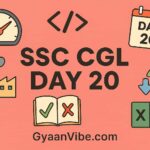GyaanVibe is a focused educational platform dedicated to helping SSC CGL aspirants crack Tier 1 & Tier 2 exam with a strategic, day-wise, and well-structured preparation approach.
SSC CGL Preparation – Day 17
Reasoning – Coding-Decoding (Repeated)
🔍 What is Coding-Decoding?
In this topic, a word, letter, or number is coded using a pattern or rule. Your job is to decode the pattern and answer questions based on it.
SSC CGL commonly asks both simple letter substitution and advanced logic-based patterns.
🧠 Types of Coding-Decoding
| Type | Description |
|---|---|
| 1. Letter Coding | Each letter in a word is replaced by another letter |
| 2. Number Coding | Words are coded into numbers using positional or arithmetic logic |
| 3. Substitution Coding | Words are replaced with completely new ones |
| 4. Symbol/Pattern-Based Coding | Symbols or positions are involved |
| 5. Matrix Coding (Box Coding) | Coding from a grid/matrix |
| 6. Mixed Coding or Language Coding | Multiple statements coded using overlapping logic |
📘 1. Letter Coding
➡️ Letters are coded based on alphabetical positions, either:
- Forward (A=1, B=2, …, Z=26)
- Reverse (Z=1, Y=2, …, A=26)
🧪 Example:
If BIG = DJI, then how is DOG coded?
Solution:
B → D (+2),
I → J (+1),
G → I (+2)
Pattern: +2, +1, +2
Apply to DOG:
D → F, O → P, G → I
✅ Answer: FPI
📘 2. Number Coding
➡️ A word is converted into a number using logic like:
- Positional value of letters
- Sum or difference of values
- Reverse letters
🧪 Example:
If CAR = 24, BUS = 42, find the logic.
C (3) + A (1) + R (18) = 22
B (2) + U (21) + S (19) = 42
Hence, sum of letter positions = number code
📘 3. Substitution Coding
➡️ In a sentence, words are replaced with other words.
🧪 Example:
“If ‘blue’ means ‘sky’, ‘green’ means ‘grass’, and ‘yellow’ means ‘sun’,” what does ‘blue and green’ mean?
✅ Answer: sky and grass
📘 4. Symbol/Pattern Coding
➡️ Symbols represent letters or combinations.
🧪 Example:
If@ = A, $ = B, # = C
Then what does @$# mean?
✅ Answer: ABC
📘 5. Matrix Coding (Box Coding)
➡️ A table (matrix) contains letters, and a code is formed using row-column pairings.
🧪 Example:
| C1 | C2 | C3 | |
|---|---|---|---|
| R1 | A | D | E |
| R2 | B | C | F |
Code for E? → R1C3 → 13
📘 6. Mixed Coding / Language Coding
➡️ Multiple statements coded using a shared logic.
🧪 Example:
Statements:
- “Apple is sweet” → ro pi ta
- “Banana is sweet” → so ro ta
What is the code for “Apple”?
✅ Answer: Compare common codes → “is sweet” = ro, ta
→ “Apple” = pi
🔑 Tips to Crack Coding-Decoding in SSC CGL
| Tip | Explanation |
|---|---|
| 🔤 Learn A-Z positions | A=1, B=2, …, Z=26 |
| 🔁 Watch for patterns | Try +1, -1, reverse, alternate |
| ➕ Try letter sum logic | Especially for number coding |
| 👀 Eliminate wrong options | Often quicker than decoding fully |
| ✍️ Practice mapping | Use rough space to list out positions |
❗ Common Traps in SSC Exams
| Trap | Strategy |
|---|---|
| Assumption-based answers | Stick to the exact pattern |
| Not checking reverse order | Test both forward/reverse logic |
| Ignoring letter position | Use positional values regularly |
| Missing hidden repetition | Look for symmetrical/alternate logic |
🧠 Must-Practice Coding Logics
- +2, -1, +3 patterns
- Even-Odd swaps
- Mirror Alphabet (A-Z, B-Y…)
- Backward coding
- Position-based sums or gaps




